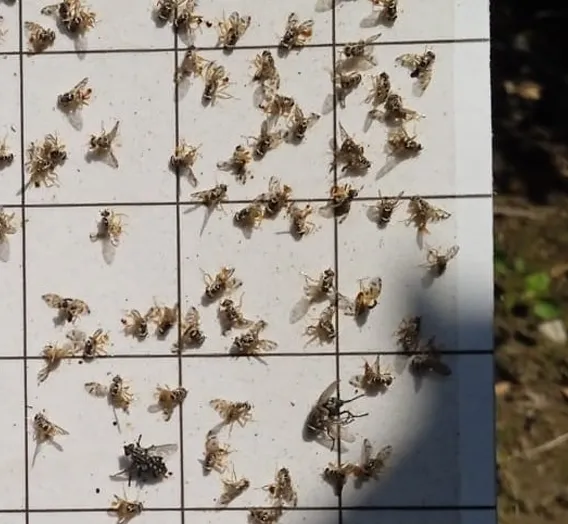Mediterranean fruit fly (Ceratitis capitata) belongs to a family of pests known for the damage it causes to citrus fruits. This fly species is widespread globally and is particularly harmful to fruits in the Mediterranean basin. It is usually active in temperate and warm climates.
Mediterranean fruit fly causes significant damage to fruits, leading to economic losses and a reduction in the market value of the products. Therefore, controlling this pest is crucial. There are various control methods, including cultural, biological, biotechnical, and chemical approaches.
Mediterranean Fruit Fly Trap
Known for its damage to fruits, Ceratitis capitata causes significant economic losses and a serious decline in the market value of the products.
The Mediterranean fly is approximately 3-5 mm in size, with yellow, brown, and black spots on its body. Females lay their larvae under the fruit skins, and these larvae feed inside the fruit once they hatch. This species produces 4-6 generations annually.
This pest overwinters as pupae under the soil, and depending on climatic conditions, adults begin to emerge by late spring or early summer. It is particularly harmful in temperate and warm climates and causes serious damage to fruits in the Mediterranean region.
Damage caused by the Mediterranean fruit fly:

Due to these losses, it is vital to combat the Mediterranean fruit fly. The methods used to control this pest include cultural, biological, chemical, and biotechnical approaches.
Methods and their features:
- Cultural Control: In this method, collecting and destroying infected fruits is crucial, as larvae continue to develop in these fruits. Additionally, cleaning up the fallen fruits after the harvest is an essential step in controlling this pest.
- Biological Control: This approach involves using natural enemies to control the population. Parasitoids and predator insects are used to keep the population in check.
- Chemical Control: Insecticides are used in chemical control, but their use requires great caution.
- Biotechnical Methods: In biotechnical control, pheromone traps are used. Since they reduce the need for chemicals, they are a frequently preferred method.
What Are the Features of Pheromone Traps in Mediterranean Fruit Fly Control?
One of the natural control methods for the Mediterranean fruit fly is pheromone traps. These traps mimic the pheromones released by female flies. The pheromone chemicals attract male flies into the trap, where they stick to adhesive surfaces and are eliminated.
The advantages of pheromone traps are:
- Easy to use and cost-effective.
- They reduce chemical use, thereby protecting the environment and human health.
- Species-specific, meaning they target only one species, preventing harm to beneficial organisms.
- Effective for monitoring and controlling the population.
The Mediterranean fruit fly pheromone trap is widely preferred due to its effectiveness in reducing chemical use, controlling the population, and being easy to monitor.

Mediterranean Fruit Fly Trap Prices
The prices of traps, a commonly used method by producers seeking solutions to fruit flies, vary. The criteria that determine these prices include the type of trap, quality, and supplier. However, traps used to combat fruit flies are preferred due to their cost-effectiveness and efficiency.
Since they reduce chemical use and protect the environment and human health, the prices of these traps vary depending on their quality, materials used, and the number of traps required. When selecting traps, all these criteria should be considered, and the choice should be solution-oriented.
Points to consider for long-term use of these traps:
- It is recommended to regularly maintain and check the traps at certain intervals.
- The pheromone capsules placed inside the traps should also be checked and replaced at regular intervals.
By paying attention to these points, it is possible to benefit from these traps for a long time.
For more information on Mediterranean fruit fly control methods and traps, you can contact Kapar Organik.
